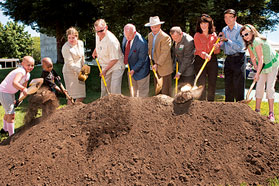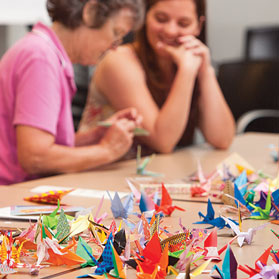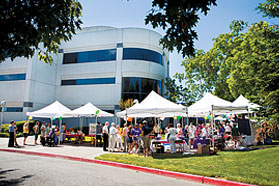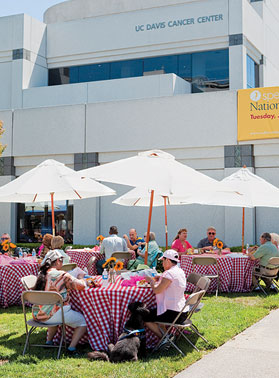First steps: An expansion for the future
 More than 300 people gathered on the center’s lawn and pathways on that warm Saturday morning in June to mark National Cancer Survivors Day and to break ground on the long-awaited cancer center expansion.
More than 300 people gathered on the center’s lawn and pathways on that warm Saturday morning in June to mark National Cancer Survivors Day and to break ground on the long-awaited cancer center expansion.
Men, women and children proudly sported blue-and-gold buttons proclaiming their number of cancer-free years. Women threw bright pink feather boas around their shoulders in honor of breast cancer survivorship. Advocacy and support group members passed out fliers, trinkets and treats. Guests took refuge from the sun in the art gallery to view inspirational artwork by Survivors Day attendee SaEeda Sharon King and others, or to create Japanese origami cranes for good luck and healing. National Football League Hall of Famer and cancer survivor Jim Otto spoke eloquently about the role the cancer center played in his treatment and recovery from prostate cancer. At lunchtime, tables with red-and-white-checkered tablecloths and white umbrellas offered views of the stage where Native American storyteller Cheewa James told a tale of healing.

The cancer center – one of only 66 designated by the National Cancer Institute – cares for more than 9,000 adults and children each year, from as far south as Fresno and as far north as the Oregon border. But outpatient visits have grown by 50 percent during the past five years, with growth projected to increase by at least 6 percent each year. And with an additional strain on resources due to the closure of some community cancer clinics in the region, the expansion is a critical component in the health system's ability to continue performing integrated and comprehensive cancer care.
 National Cancer Survivors Day, held on a Saturday morning in June, was a joyful demonstration that life after a cancer diagnosis can be meaningful, productive and full of hope.
National Cancer Survivors Day, held on a Saturday morning in June, was a joyful demonstration that life after a cancer diagnosis can be meaningful, productive and full of hope.
"We have made great strides in improving outcomes for our patients," says Ralph deVere White, cancer center director. "But our facility must be able to meet the increasing demand for care."
The 46,000-square-foot expansion, to be completed in 2012, will connect to the existing cancer center via a second-floor bridge on the northern side that overlooks a courtyard. The project also will include remodeling about 9,000 square feet of the existing building. Eventually, another 40,000-square-foot addition will be built to accommodate more clinical trials and to house the radiation oncology department.
"We have made great strides in improving outcomes for our patients. But our facility must be able to meet the increasing demand for care."
National renown and construction aside, the intent of the cancer center is always to provide a smoother, more soothing path for the patients who travel its corridors and visit its exam and treatment rooms.
Young patients now are seen at various locations around the medical campus. For example, 10-year-old Parmina Valentine, another Survivors Day attendee, would begin her chemotherapy cycles at the infusion center in one building, then had to linger until transportation was available to take her to the main hospital nearly three blocks away, then sometimes had to wait for a pediatric room to become available.
The new addition will smooth the geographic transition for Parmina and other young patients. By housing both pediatric and adult oncology services, the expansion will ensure more seamless access to physicians, nurses and treatment options for all patients – particularly vital for adolescents who are undergoing the transition from pediatric to adult care.
 The cancer center – one of only 66 designated by the National Cancer Institute – cares for more than 9,000 adults and children each year, from as far south as Fresno and as far north as the Oregon border.
The cancer center – one of only 66 designated by the National Cancer Institute – cares for more than 9,000 adults and children each year, from as far south as Fresno and as far north as the Oregon border.
"We need room to see everyone in one place," deVere White says. "Pediatric cancers are devastating. By co-locating children and adult services, we hope that pediatric oncology can leverage the more vast resources available for adult cancers. It’s more economical for us, but it’s also of greater benefit to the patient."
DeVere White believes that putting children and adult services together also can benefit the emotional well-being of patients.
"Having adults and children interact helps keep a sense of perspective, and can provide inspiration and hope to older patients," he says.
At the same time, children also will have their own comfortable space. The pediatric hematology-oncology and infusion clinics will have play areas, isolation rooms, DVD players and other features to make the visits of young patients as pleasant as possible.
On a more practical note, co-locating resources also will benefit clinical researchers, basic scientists and physicians by helping them keep pace with the growth of much-needed clinical trials and research programs. The cancer center integrates the work of 179 scientists in 317 research projects dedicated to cancer treatment, including external research partnerships with the Lawrence Livermore National Laboratory, the California Department of Health Services, different departments and colleges of UC Davis, and other entities.
Historically lacking sufficient resources, clinical research is now much more complex than ever.
"Trials have become far more complicated, and we have to develop a cadre of people who have the expertise to conduct them," deVere White says. "To be able to quicken the pace by which we make discoveries in the lab and get them to the patients, we need dedicated physician-scientists – and we need the space. If we are to truly bring our resources and expertise to the population of Northern California, it’s important that our whole base be as strong as possible."
"To be able to quicken the pace by which we make discoveries in the lab and get them to the patients, we need dedicated physician-scientists – and we need the space."
The cancer experience is a journey, at once frightening and illuminating, that millions take every year. The UC Davis Cancer Center expansion project, which continues its fundraising efforts to reach $35 million, will help support all members of the UC Davis Cancer Center family: those who came out on Cancer Survivors Day, those who will attend in the future, and those who endeavor to provide the best care and outcomes possible for each one of them.











